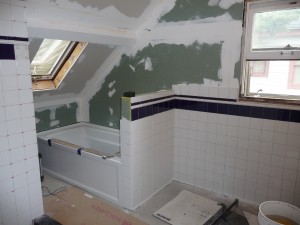
Are you planning a new bathroom remodel? Don’t let it become a nightmare. Here are five common mistakes and how to avoid them.
Along with kitchens, bathrooms are the rooms homeowners most frequently want to renovate. A good bathroom is stylish, luxurious, functional and comfortable. But getting there isn’t always easy, and many homeowners make costly or time-consuming mistakes. Here are the top five mistakes to avoid when remodeling your bathroom:
- Too much bathroom in too little space.
One of the most common problems with bathrooms is that they end up feeling crowded, too small or inconveniently arranged. This is especially true when adding a new bathroom where there wasn’t one before. Think carefully about how doors and drawers will open, whether a sloping ceiling will be a bother, and whether you really have space for the fixtures you’re choosing. Consider a pedestal sink in lieu of a vanity, with some shelving high up on the wall.
- Getting the most inexpensive contractor.
Bathrooms are among the projects most likely to run over budget and past deadline. This is because they often require plumbing, electrical, and tile work on top of routine renovation. As a result, you need to look at quotes from contractors very carefully. If one is lower, make sure absolutely everything is included before you jump on it, and only pay half up front.
- Poor ventilation or no ventilation.
Ventilation is absolutely essential in a bathroom, even when there is no shower/bath. There will be moisture in every bathroom and if it isn’t being vented it will lead to mildew or mold, which fuels sickness and allergies. As a general rule of thumb, if you have no way of venting a space then it shouldn’t be a bathroom.
- Materials that won’t last or low quality materials.
Bathroom fixtures come in a wide range of styles and price points. Likewise, flooring ranges from the low-cost rolls to expensive tile. We all need to stay within budget, but try to aim for at least the mid-level bathroom fixtures. They really will hold up longer and look better for years to come.
- A wasteful water heater.
If you’re adding a new bathroom, don’t make the mistake of investing in an old fashioned tank-based water heater. A tankless water heater will save you big money on energy bills and provide hot water on demand. By providing proper maintenance and replacing your water heater when necessary will give you years of enjoyment in your new bathroom remodel.










